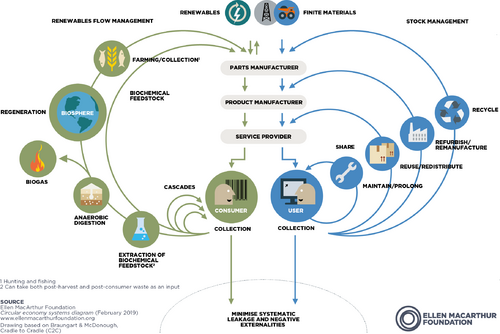Circular Economy in Project Management
Abstract
In recent years sustainability and waste reduction have been some of the main focuses in manufacturing industries. This is due to the need of decreasing current environmental impacts and securing minimal future impacts. In terms, project management is being considered sustainable if it achieves long-terms benefits [1]. This can be problematic for large-scale companies, as they are more difficult to change structurally. However, the long-term benefits can be achieved using Circular Economy. Circular Economy is a method used to mitigate the environmental impacts by using materials much more efficiently [2].
Circular Economy is an approach that works alongside the corporate strategy and business development, which is used in project and portfolio management to reduce waste by introducing new methods of reusing, refurbishing, repairing, recycling, leasing, and sharing existing resources that prolongs the products life cycle [3]. This gives the company opportunities to reinvent their products so that they can create circular systems that makes it possible for already sold products to be part of a new product. For that reason, Circular Economy should be a crucial part of project and portfolio management both in regard to the design and planning of new products, but also in the assessment of existing products.
Implementing Circular Economy may both reduce waste, but also improve finance, as fewer raw materials may be needed. This benefit is ideal for competitiveness and securing more reliable sources of acquiring raw material needed for new products.
Contents |
Circular Economy
Circular Economy is an approach that moves away from the linear system of producing and consuming, and instead goes towards a circular system of reuse. Linear systems are the most common to use, as the company do not have to make any logistics in getting the materials back. However, this results in the materials going lost after the use of the consumer.
With a circular system instead it is possible to make use of the already mined materials to produce products that gives value to the customer.
What is a Circular Economy?
Generally we can differentiate Circular Economy in two systems, one being the biological cycle and the other being the technical cycle. This differentiation is important due to the types of circular system that could be implemented. In the biological cycle we engage with the consumer, whereas the technical cycle we engage with the user. A biological cycle consists of products such as food, chemicals or biological products that are not possible to become a new product by its own. However, they can become soil and be used as a biological material for the production of new products. A techical cycle consists of products that are made of extracted materials and do not biodegrade. This could be electronics, plastics, and everyday products. The materials in the technical cycle are those that are most attractive to recover, as they most often are valuable to the producers.
One of the key challenges that we currently are facing is that we mix the biological products with the technical products, which makes the biodegradability useless. This is for instance the case with textiles.
Due to this differentiation it is important to analyse the products in a companies portfolio in order to identify what their products include and which type of cycle is implementable.
Directly linked to the technical cycle we have the following options:
- Reusing
- Reusing is the option of reusing a material or component in a new product. This could be products containing high-quality material.
- Examples of these products could be electronics
- Many components in electronics can last for many years, which makes them ideal in the production of newer products.
- Refurbishing
- Refurbishing is the option of remanufacturing the component. With this process the raw-material is treated and reused for the production of a new component.
- Refurbishing is more expensive than reusing, as more manufacturing processes are needed. However, the process will ensure a much more similar result as a new product.
- Repairing
- Recycling
- Leasing
- Sharing
Circular Economy Benefits
With circular systems it is possible for the company to reach new market opportunities, as they can make profit in many new ways.
Why is Circular Economy important?
Circular Economy Implementation
Solution Approaches
How to analyse your portfolio for possible circularity
Circular Economy Limitations
Difficulties companies could face when implementing Circular Economy
References
- ↑ Circular Economy in Project Management, Prosense Consulting, https://www.prosense-consulting.com/en/sustainable-project-management-brings-circular-economy-to-life/
- ↑ What is a Circular Economy?, United States Environmental Protection Agency, https://www.epa.gov/recyclingstrategy/what-circular-economy
- ↑ Circular Economy Introduction, Ellen MacArthur Foundation, https://ellenmacarthurfoundation.org/topics/circular-economy-introduction/overview
Other key materials:
1. Portfolio Management: The standard for portfolio management, 4th Edition (2018)
2. Portfolio Management: ISO 21504 (2015 Edition)
